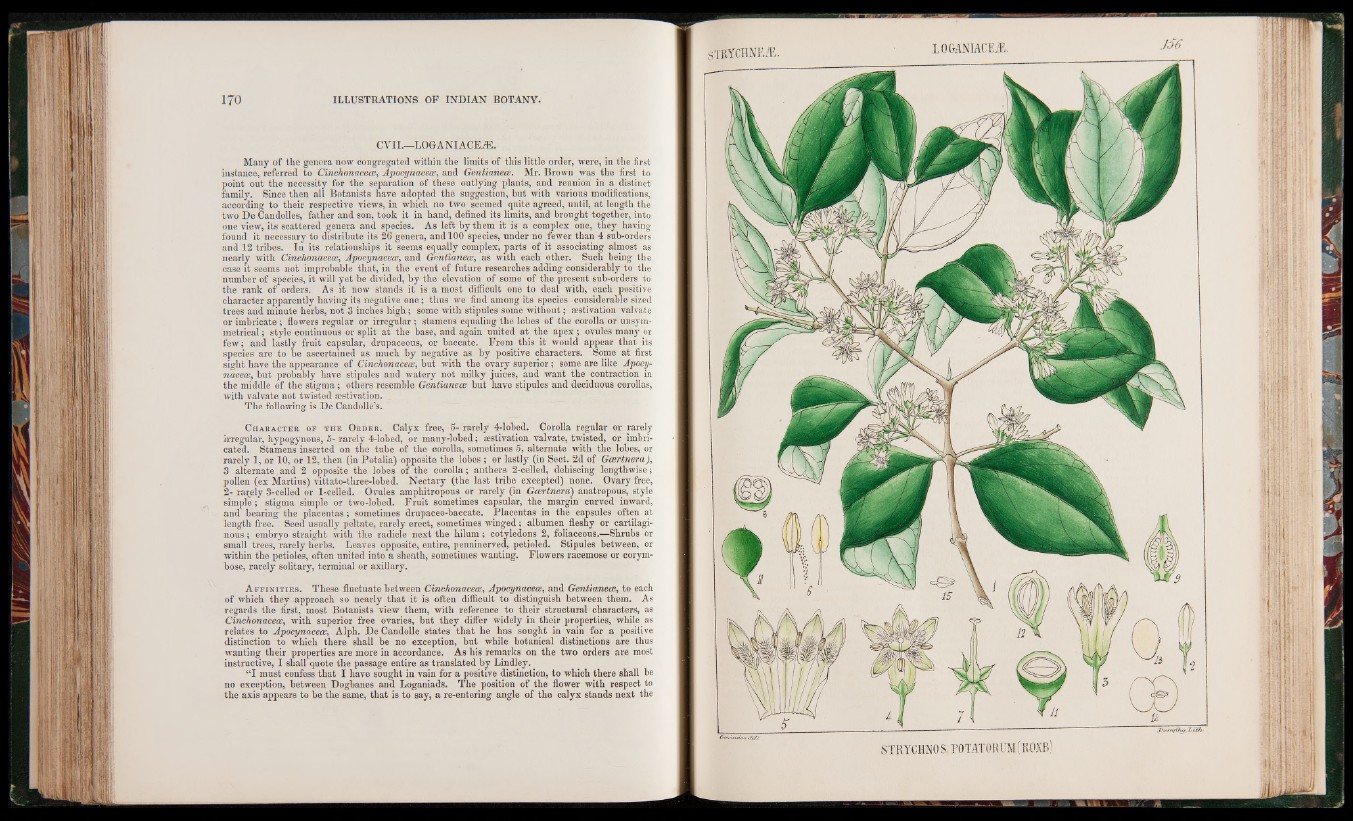
CVII.—LOGANIACEiE.
Many of the genera now congregated within the limits of this little order, were, in the first
instance, referred to Cinchonacece, Apocynaceoe, and Gentianece. Mr. Brown was the first to
point out the necessity for the separation of these outlying plants, and reunion in a distinct
family. Since then all Botanists have adopted thé suggestion, but with various modifications,
according to their respective views, in which no two seemed quite agreed, until, at length the
two De Candolles, father and son, took it in hand, defined its limits, and brought together, into
one view, its scattered genera and species. As left by them it is a complex one, they having
found it necessary to distribute its 26 genera, and 100 species, under no fewer than 4 sub-orders
and 12 tribes. In its relationships it seems equally complex, parts of it associating almost as
nearly with Cinchonacece, Apocynaceoe, and Gentianece, as with each other. Such being the
case it seems not improbable that, in the event of future researches adding considerably to the
number of species, it will yet be divided, by the elevation of some of the present sub-orders to
the rank of orders. As it now stands it is a most difficult one to deal with, each positive
character apparently having its negative one; thus we find among its species considerable sized
trees and minute herbs, not 3 inches high; some with stipules some without; aestivation valvate
or imbricate ; flowers regular or irregular; stamens equaling the lobes of the corolla or unsyin-
metrical; style continuous or split at the base, and again united at the apex; ovules many or
few; and lastly fruit capsular, drupaceous, or baccate. From this it would appear that its
species are to be ascertained as much by negative as by positive characters. Some at first
sight liave the appearance of Cinchonacece, but with the ovary superior; some are like Apocy-
nacece, but probably have stipules and watery not milky juices, and want the contraction in
the middle of the stigma; others resemble Gentianece but have stipules and deciduous corollas,
with valvate not twisted aestivation.
The following is De Candolle’s.
Character of the Order. Calyx free, 5- rarely 4-lobed. Corolla regular or rarely
irregular, hypogynous, 5- rarely 4-lobed, or many-lobed; aestivation valvate, twisted, or imbricated.
Stamens inserted on the tube of the corolla, sometimes 5, alternate with the lobes, or
rarely 1, or 10, or 12, then (in Potalia) opposite the lobes ; or lastly (in Sect. 2d of Gcertnera),
3 alternate and 2 opposite the lobes of the corolla; anthers 2-celled, dehiscing lengthwise;
pollen (ex Martius) vittato-three-lobed. Nectary (the last tribe excepted) none. Ovary free,
2- rarely 3-celled or 1-celled. Ovules amphitropous or rarely (in Gcertnera) anatropous, style
simple; stigma simple or two-lobed. Fruit sometimes capsular, the margin curved inward,
and bearing the placentas; sometimes drupaceo-baccate. Placentas in the capsules often at
length free. Seed usually peltate, rarely erect, sometimes winged; albumen fleshy or cartilaginous
; embryo straight with the radicle next the hilum; cotyledons 2, foliaceous.—Shrubs or
small trees, rarely herbs. Leaves opposite, entire, penninerved, petioled. Stipules between, or
within the petioles, often united into a sheath, sometimes wanting. Flowers racemose or corymbose,
rarely solitary, terminal or axillary.
A f f in it ie s . These fluctuate between Cinchonacece, Apocynaceoe, and Gentianece, to each
of which they approach so nearly that it is often difficult to distinguish between them. As
regards the first, most Botanists view them, with reference to their structural characters, as
Cinchonacece, with superior free ovaries, but they differ widely in their properties, while as
relates to Apocynaceoe, Alph. De Candolle states that he has sought in vain for a positive
distinction to which there shall be no exception, but while botanical distinctions are thus
wanting their properties are more in accordance. As his remarks on the two orders are most
instructive, I shall quote the passage entire as translated by Lindley.
“I must confess that I have sought in vain for a positive distinction, to which there shall be
no exception, between Dogbanes and Loganiads. The position of the flower with respect to
the axis appears to be the same, that is to say, a re-entering angle of the calyx stands next the
STRYCHNEÆ. 10GANIACEÆ. JS€
STRYCHNOS POTATORUM [ROXES)